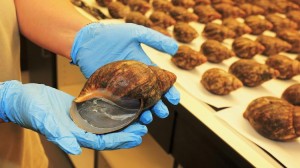California Governor Edmund G. Brown Jr. will travel to Mexico City next week to meet with Mexican government and business leaders, help boost bilateral trade and investment opportunities between the two neighbors and expand environmental and economic cooperation.
Governor Brown also announced today that he has invited Mexican President Enrique Peña Nieto to meet later this year in California to build on the partnership forged during the trade mission. Ahead of the trip, Governor Brown will meet with Mexico’s Secretary of Foreign Affairs José Antonio Meade Kuribreña in Sacramento today.
The Governor will be joined on the Trade and Investment Mission to Mexico by a delegation of state legislators and senior administration officials (including CDFA Secretary Karen Ross). A delegation organized by the California Chamber of Commerce with the help of the California Foundation for Commerce and Education that includes approximately 90 business, economic development, investment and policy leaders from throughout California will also participate in the trade mission.
The Governor first announced the Trade and Investment Mission to Mexico in his 2014 State of the State address and met with Mexican Consuls General from cities across California in March.
The trip follows Governor Brown’s 2013 Trade and Investment Mission to China. Over the past year, Governor Brown has also signed accords with leaders from Canada, Israel and Peru to combat climate change, strengthen California’s economic ties and expand cooperation on promising research. In February, Governor Brown established the California International Trade and Investment Advisory Council to help expand international business opportunities for California companies and appointed former U.S. Ambassador to Hungary Eleni Kounalakis as chair.
A preliminary itinerary of trade mission meetings and events is below. All events, times and locations are subject to change and require RSVPs from in-country reporters. Please note that all times are local, and unless specified, represent start times for events and meetings. Allow for ample check-in time. Updates to the itinerary will be reflected in the online media advisory at: www.gov.ca.gov.
Today, Wednesday, July 23, 2014
Sacramento Luncheon with Mexico’s Secretary of Foreign Affairs José Antonio Meade Kuribreña
When: Today, July 23, 2014. Members of the media must check in between 12:15 p.m. and 12:30 p.m. and will be seated at 12:40 p.m. Remarks will begin at approximately 12:50 p.m. A media availability will follow.
Where: California Chamber of Commerce, Esquire Plaza Building, California Room, 1215 K Street, 14th Floor, Sacramento, CA 95814
Media Coverage: The luncheon’s speaking program and media availability are open to invited guests and credentialed media only.
Monday, July 28, 2014
Meeting with the Governor of the State of Mexico Eruviel Ávila
When: Monday, July 28, 2014 at 8:00 a.m.
Where: Location is to be determined.
Media Coverage: The first few minutes of this meeting will be open to credentialed media only. In-country reporters interested in covering the meeting must RSVP by 5:00 p.m. Friday, July 25, 2014 to Raúl Vargas at raoulvargas@gmail.com with name, outlet and contact information.
California-Mexico Climate Change Memorandum of Understanding Signing and Summit with Mexico’s Ministry of Environment and Natural Resources
When: Monday, July 28, 2014 at 12:30 p.m.
Where: Ministry of Foreign Affairs, Salón Morelos, Plaza Juarez 20, Cuauhtémoc, Centro, 06010 Mexico City, DF, Mexico
Media Coverage: This event will be open to credentialed media only. In-country reporters interested in covering the meeting must RSVP by 5:00 p.m. Friday, July 25, 2014 to Daniel Millan at dmillan@sre.gob.mx with name, outlet and contact information.
Visit California and AeroMexico Campaign Launch Press Conference
When: Monday, July 28, 2014 at 5:00 p.m.
Where: AeroMexico Offices, Paseo de la Reforma 445, Cuauhtémoc, 06500 Mexico City, DF, Mexico
Media Coverage: The press conference will be open to credentialed media only. In-country reporters interested in covering the press conference must RSVP by 5:00 p.m. Friday, July 25, 2014 to Roxana Perez at Roxana.Perez@1gms.com with name, outlet and contact information.
Media Availability with U.S. Ambassador to Mexico E. Anthony Wayne
When: Monday, July 28, 2014 at 6:45 p.m.
Where: Soumaya Museum, Miguel de Cervantes Saavedra 303, Granada, Miguel Hidalgo, 11529 Mexico City, DF, Mexico
Media Coverage: The media availability will be open to credentialed media only and follows a private meeting between the Governor and Ambassador. In-country reporters interested in covering this media availability must RSVP by 5:00 p.m. Friday, July 25, 2014 to the U.S. Embassy Press Office at emlistmx@state.gov with name, outlet and contact information.
Tuesday, July 29, 2014
California-Mexico Higher Education Memorandum of Understanding Signing and Breakfast with Mexico’s Ministry of Education
When: Tuesday, July 29, 2014 at 9:30 a.m.
Where: Casa de California, Carmen 1, Chimalistac, Alvaro Obregon, 01070 Mexico City, DF, Mexico
Media Coverage: This event will be open to invited guests and credentialed media only. In-country reporters interested in covering this event must RSVP by 5:00 p.m. Friday, July 25, 2014 to Daniel Millan at dmillan@sre.gob.mx with name, outlet and contact information.
Meeting with Mexico’s Secretary of Energy Pedro Joaquín Coldwell
When: Tuesday, July 29, 2014 at 11:30 a.m.
Where: Ministry of Energy, Insurgentes Sur 890, Col. Del Valle, Benito Juarez, 03100 Mexico City, DF, Mexico
Media Coverage: The first few minutes of this meeting will be open to credentialed media only. In-country reporters interested in covering the meeting must RSVP by 5:00 p.m. Friday, July 25, 2014 to Daniel Millan at dmillan@sre.gob.mx with name, outlet and contact information.
Meeting with Mexico’s President of the Senate Raúl Cervantes Andrade
When: Tuesday, July 29, 2014 at 1:00 p.m.
Where: Senado de la República, Av. Paseo de la Reforma 135, Insurgentes Centro, Col. Tabacalera, 06030 Mexico City, DF, Mexico
Media Coverage: The first few minutes of this meeting will be open to credentialed media only. In-country reporters interested in covering the meeting must RSVP by 5:00 p.m. Friday, July 25, 2014 to Beatriz Alfaro at betrichealfasenado@gmail.com with name, outlet and contact information.
American Chamber of Commerce of Mexico Luncheon and Media Availability
When: Tuesday, July 29, 2014 at 2:45 p.m. A media availability will follow.
Where: Hotel Camino Real Polanco, Molino Del Rey Room (luncheon) and Taxco Room (media availability), Mariano Escobedo 700, Anzures, Miguel Hidalgo, 11590 Mexico City, DF, Mexico
Media Coverage: The event and media availability will be open to credentialed media only. In-country reporters interested in covering this event and media availability must RSVP by 5:00 p.m. Friday, July 25, 2014 to Esther Gil Ordaz at egil@e-beaconpr.com with name, outlet and contact information.
Wednesday, July 30, 2014
California-Mexico Trade and Investment Memorandum of Understanding Signing and Breakfast with Mexico’s Secretary of Foreign Affairs José Antonio Meade Kuribreña and Secretary of Economy Ildefonso Guajardo Villarreal
When: Wednesday, July 30, 2014 at 9:00 a.m.
Where: Club de Industriales, Ballroom, Andrés Bello 29, Polanco, 11550 Mexico City, DF, Mexico
Media Coverage: This event will be open to credentialed media only and follows private meetings between the Governor and Secretary of Foreign Affairs and Secretary of Economy. In-country reporters interested in covering this event must RSVP by 5:00 p.m. Friday, July 25, 2014 to Daniel Millan at dmillan@sre.gob.mx with name, outlet and contact information.
Media Availability with Mexico’s Secretary of Labor and Social Welfare Alfonso Navarrete Prida
When: Wednesday, July 30, 2014 at 10:30 a.m.
Where: Club de Industriales, Auditorium, Andrés Bello 29, Polanco, 11550 Mexico City, DF, Mexico
Media Coverage: The media availability will be open to credentialed media only and follows a private meeting between the Governor and the Secretary. In-country reporters interested in covering this meeting must RSVP by 5:00 p.m. Friday, July 25, 2014 to Daniel Millan at dmillan@sre.gob.mx with name, outlet and contact information.
For social media updates and other announcements throughout the trade mission, please follow these twitter handles: @CAMexicoTrade; @JerryBrownGov; @GovPressOffice; @CAGoBiz; @CalChamber; @VisitCA.
Press releases and other content will also be posted at: www.business.ca.gov/MexicoTrade.aspx
**NOTE: A Spanish translation of this release can be found here.









